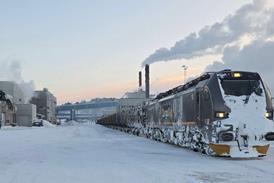GERMANY: Our editorial office recently received an e-mail highlighting a special menu available in Deutsche Bahn dining cars. All dishes featured fresh mutton, and at the bottom of the page customers were invited to take advantage of a special offer for a limited number of woolly jumpers.
For those who haven't guessed, the menu was a rather tasteless spoof relating to a bizarre accident on April 26 when a Hamburg - München ICE1 derailed at around 200 km/h in the 10·8 km Landrücken tunnel near Fulda after encountering a flock of sheep near the entrance. Both power cars and 10 of the 12 trailers left the rails, but the tunnel walls helped to keep the coaches upright. Only 19 of the 135 passengers were injured, four of them seriously, and DB's emergency services and procedures emerged with flying colours.
Inevitably, the accident relaunched a debate within Germany about whether railway lines should be fenced. Many of the world's railways are unfenced, and there is no reason for the policy to change - people are more likely to be injured or killed when crossing roads. High speed lines, however, are generally protected - the Shinkansen in Japan are fully enclosed, and the LGV network in France is fenced throughout. To our knowledge, Germany remains unique in having unfenced sections of high speed line, one reason being that legal responsibility for preventing the escape of livestock rests with the farmer.
After the ICE derailment DB Chairman Hartmut Mehdorn promised, perhaps rashly, to ensure that such an accident would never happen again. Whether this means erecting fencing after all or installing intrusion detection equipment is not clear. The Federal Railway Office takes the view that fencing could even have a negative effect, preventing passengers moving away from a derailed train before rescue services had cut through the fence. Similarly, animals that had somehow gained access to the alignment would be trapped on the tracks.

















